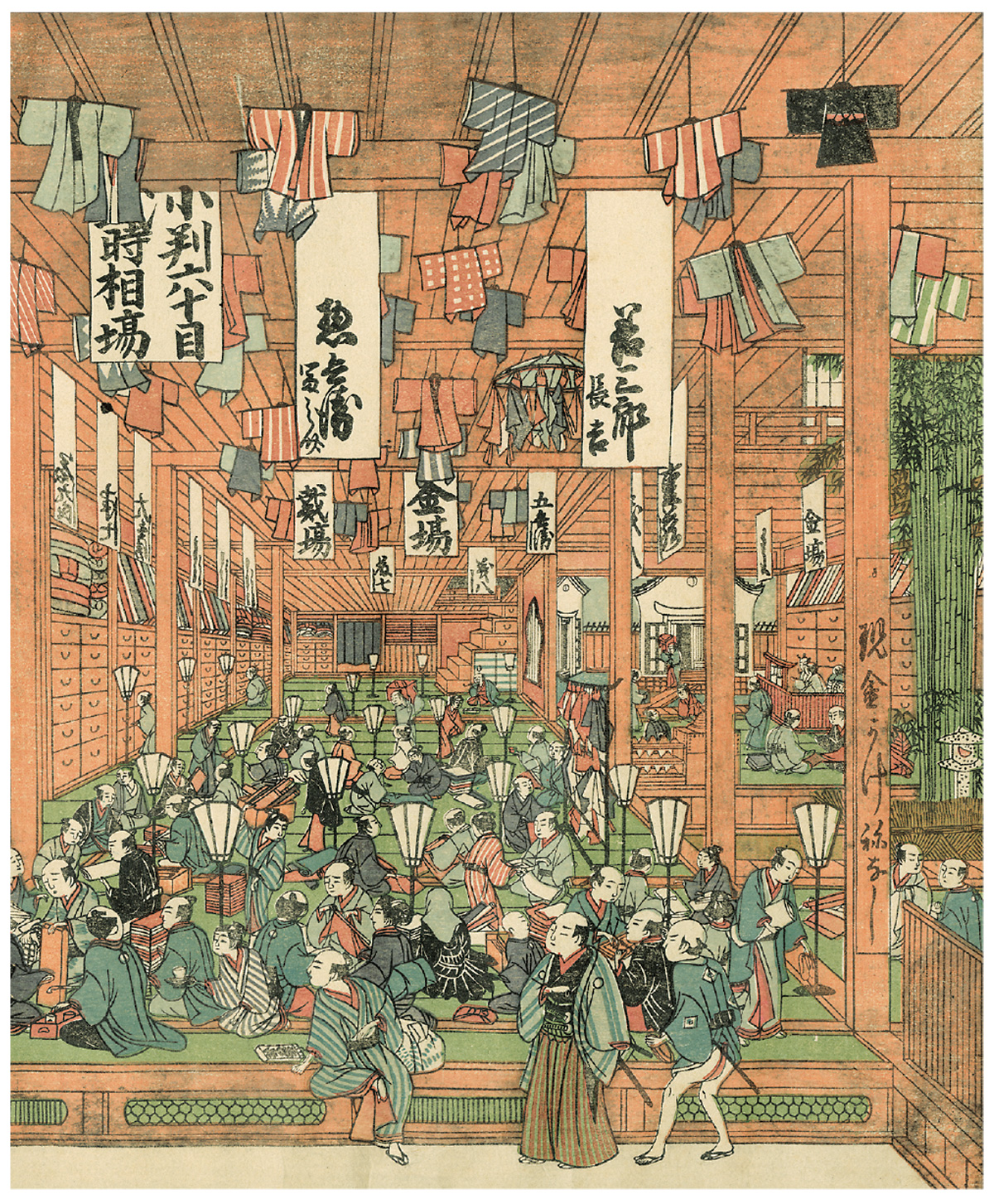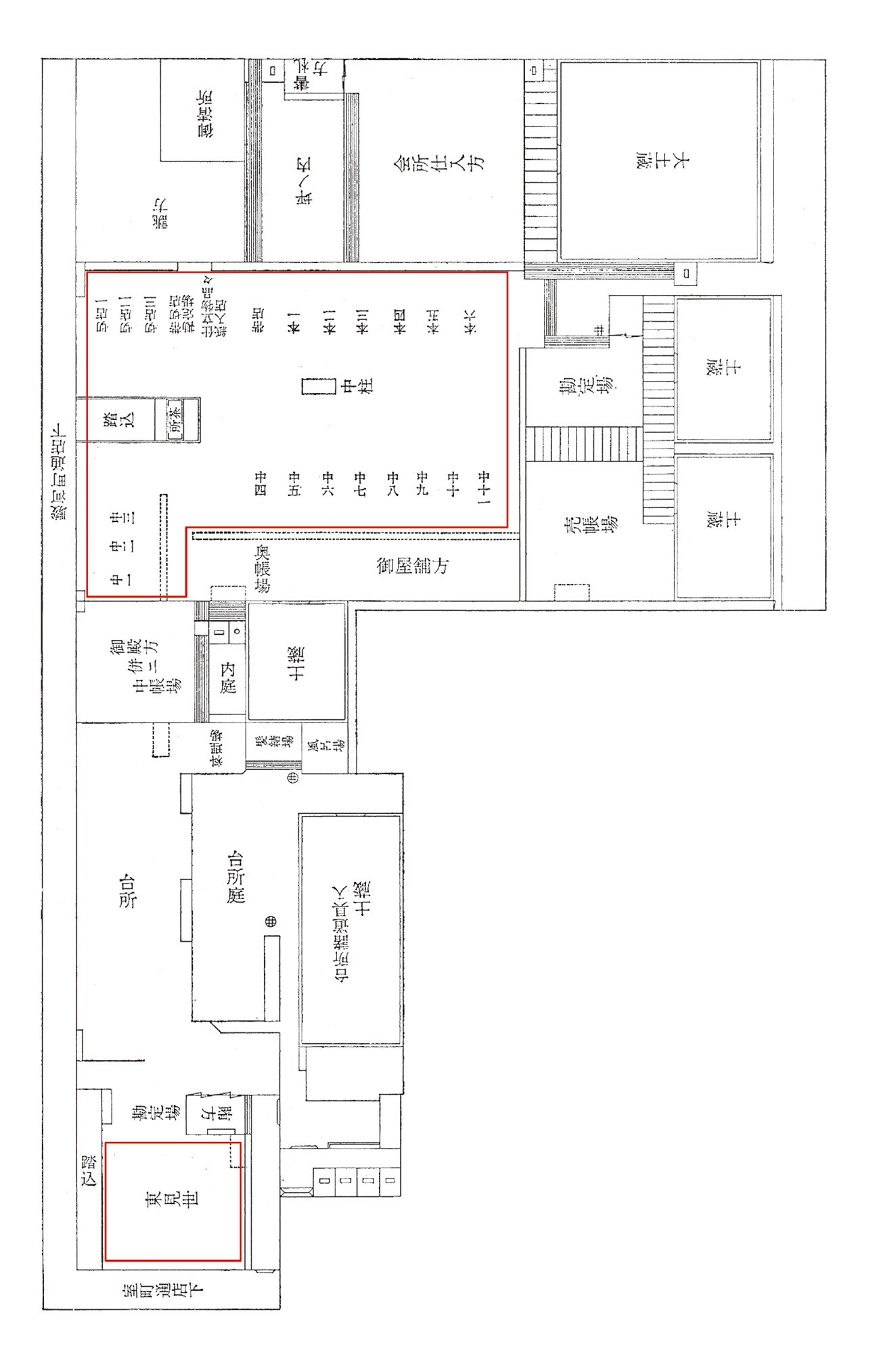13 Kimono Fabric Shops (2): Tanasaki Uri and Large Shops

Practicing Tanasaki Uri
Mitsui’s kimono division conducted business as Mitsui Echigoya with the mottos genkin kakene nashi (cash basis at fixed prices) (→04) and tanasaki uri (storefront sales). The latter refers to over-the-counter sales that were, in principle, made in cash. At the same time, credit sales prevailed during the Edo period. Since this involved the risk of default, it was a business practice that Echigoya preferred to avoid. Still, given prevailing practice, credit sales were not uncommon even for Echigoya during early modern period.
For example, during the 1790s, the ratio of storefront fell significantly, which became a major problem. The Kyoto kimono shop proposed solutions, exchanged letters with senior managers in Edo, and sometimes senior managers from Edo traveled to Kyoto for discussions. Echigoya continued to work tirelessly to preserve the primacy of storefront sales in its business.
The Uriba
The front line of storefront sales activity was the uriba (sales area), the spaces situated within each shop where customers were received. These areas were not physically separated, but each had its designated sales staff (→19) who competed with others to make storefront sales. The Edo kimono shop, for example, included two blocks of space known respectively as the honmise (main showroom) and the higashimise (east showroom), each with multiple sales areas (→Fig. 13b). In 1736, the Edo kimono shop had 12 sales areas, increasing to 29 by 1766, the highest known number. The number of sales areas fluctuated, but the Edo kimono shop generally had more than 20 at any given time.
Receiving Customers
Echigoya maintained a detailed set of employee regulations (→20). For example, apprentices were required to prepare tobacco, smoking implements, and tea for customers immediately upon their arrival. Apprentices were not allowed to stand in the presence of customers; they had to stay by the salesperson’s side and watch for shoplifting, and when not otherwise needed, wait politely to be called upon. Sales staff would read out these regulations to apprentices regularly. At the same time, whenever Echigoya reformed its shop management, the attitude of sales staff receiving customers was often one of the problems at issue.
A Variety of Departments
Echigoya’s shops housed a variety of departments handling tasks other than the uriba. The yashikikata made the rounds of wealthy customers, who might be in need of additional services; the urichoba and kanjoba oversaw business matters; the atsuraekata handled the procurement of kimonos ordered by daimyos. There was also a great kitchen to feed the sales staff, and earthen-walled warehouses adjacent to the shop where large amounts of merchandise and documents could be stored in fire-resistant environments. The second floor had a spacious hall facing the street. There were also rooms for senior managers and Mitsui family members who were visiting Edo, rooms where business meetings and conferences were likely held, and so on.
A Giant Among Kimono Shops
Because they housed extensive sales areas and many other departments and facilities, Echigoya’s shops were extremely large structures. While the street frontage of most commercial establishments is believed to have been roughly four to six meters, at its greatest extent the Echigoya Edo kimono shop’s east-west frontage was approximately 65 meters. Among kimono fabric shops, only a select few, such as Daimaru and Iwakimasuya, exceeded 60 meters of frontage.
Edo Meibutsushi Shohen (Poems to famous places of Edo, first series), published in the 19th century, includes these verses: “Mitsui’s shops sprawl along both sides of the road. Peek inside-the office that the employee has set out for is very far away.” The first verse describes the majesty of Echigoya in Surugacho, with the Edo kimono shop and the Muko shop facing it, while the second depicts the vastness of the shop interior with the distance an employee has to go to obtain the seal for a document. Enormous kimono fabric shops like Echigoya were symbols of giant cities like Edo and Osaka.

A depiction of the interior of Echigoya’s Edo kimono shop, by Utagawa Toyoharu. The artist’s use of perspective techniques and representation of the ceiling height brilliantly convey the scale of the shop. We are looking west from the eastern side of the higashimise. There are multiple sales areas, each with its employees, and banners with the name of each salesperson hanging from the ceiling. We can also see clothing samples suspended from the ceiling and banners with the names of individual departments. The interior of the shop is thronged with men and women alike; here and there sales staff help customers wanting to negotiate or evaluate the quality of the merchandise. Apprentices rush about, bringing tea for customers and samples of merchandise to examine. The print allows us to experience the bustle and energy of the Edo kimono shop.

This floorplan shows the floor plan prior to 1757. The location is approximately that of today’s Mitsui Main Building. South is to the left, with the Muko shop on the other side of Surugacho Avenue, where the Nihonbashi Mitsukoshi Main Store stands today. The Edo kimono shop was subsequently expanded and remodeled several times. Later floor plans show the kitchen moved to the west and a revised sales area layout. Sales areas are outlined in red.
